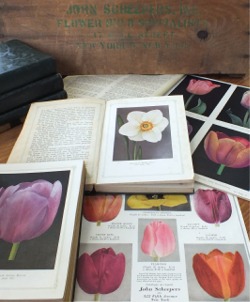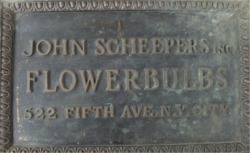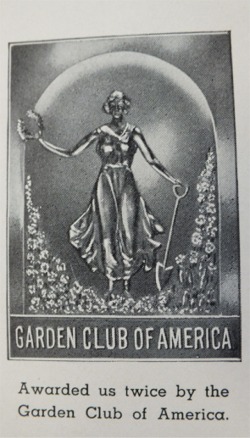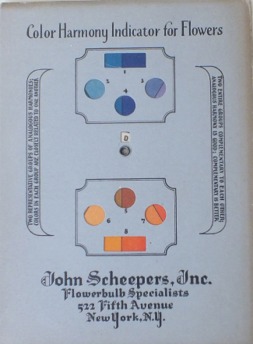 John Theodore Scheepers
John Theodore Scheepers
John Theodore Scheepers was born in Arnhem in the Netherlands on January 20, 1878, son of Johannes Theodore Scheepers and Anna Berendina Carolina van Heauman.
In 1897, John Scheepers came to America at the age of nineteen, quite a bold and adventurous undertaking for a young Dutch man at that time. On the boat, he met a Dutch bulb exporter who offered him the position of American representative of his firm.
 John Scheepers became a naturalized citizen of the United States in 1905. According to Mr. Harry T. Burn of Niota, Tennessee, the great nephew of Rose Dorothy Heywood, his beautiful and charming Aunt Rose met John T. Scheepers while attending social gatherings in Washington, D.C. She was born in Troy, Ohio on June 22, 1885, and raised in Boston, Massachusetts. Methodist Minister Charles A. Littlefield officiated their 1910 marriage in Lynn, Massachusetts. In the following years, according to Mr. Burn, the Scheepers moved to a well-appointed residence at 173 Riverside Drive in New York City. The couple summered at a cottage that they had built in the middle of Benjamin Cottrell's Fox Hill Farm in Jamestown, Rhode Island. Mr. Burn remarked that it was referred to as 'Rose's Cottage' by the family. Benjamin Cottrell was the husband of Mrs. Rose Scheepers' sister, Agnes Heywood Cottrell. This photograph of Mrs. John T. Scheepers appeared in the 1929 Beauty from Bulbs catalog with the caption, "Natural Beauty at Paradou".
John Scheepers became a naturalized citizen of the United States in 1905. According to Mr. Harry T. Burn of Niota, Tennessee, the great nephew of Rose Dorothy Heywood, his beautiful and charming Aunt Rose met John T. Scheepers while attending social gatherings in Washington, D.C. She was born in Troy, Ohio on June 22, 1885, and raised in Boston, Massachusetts. Methodist Minister Charles A. Littlefield officiated their 1910 marriage in Lynn, Massachusetts. In the following years, according to Mr. Burn, the Scheepers moved to a well-appointed residence at 173 Riverside Drive in New York City. The couple summered at a cottage that they had built in the middle of Benjamin Cottrell's Fox Hill Farm in Jamestown, Rhode Island. Mr. Burn remarked that it was referred to as 'Rose's Cottage' by the family. Benjamin Cottrell was the husband of Mrs. Rose Scheepers' sister, Agnes Heywood Cottrell. This photograph of Mrs. John T. Scheepers appeared in the 1929 Beauty from Bulbs catalog with the caption, "Natural Beauty at Paradou".
 Within several years, John Scheepers founded his own flower bulb importing firm: John Scheepers, Inc. He published the Beauty from Bulbs catalog that became known as the premier resource for Dutch flower bulbs in the United States. For decades, the Beauty from Bulbs catalog was published as a hard-cover book with beautiful watercolor illustrations, effusive romantic poetry about the beauty of flowers and the importance of gardens in one's life. In the 1929 edition, John Scheepers wrote:
Within several years, John Scheepers founded his own flower bulb importing firm: John Scheepers, Inc. He published the Beauty from Bulbs catalog that became known as the premier resource for Dutch flower bulbs in the United States. For decades, the Beauty from Bulbs catalog was published as a hard-cover book with beautiful watercolor illustrations, effusive romantic poetry about the beauty of flowers and the importance of gardens in one's life. In the 1929 edition, John Scheepers wrote:
"In four ways do the blessings of the garden (and in many another way, no doubt) descend upon those who love it. And all four blessings follow on active participation in its work. For it is a truth, too vital ever to be forgotten, that the joy of the garden is to the gardener, just as the song is to the singer and the love to the lover. It never fails."
 He mused that the four blessings of the garden were the benediction of a tired body, the creation of beauty, the adventure and the tranquillity. He wrote about flower bulbs as one would write about one's own children, with exquisite descriptions detailing every aspect of each flower's color, form, performance, disposition and impact.
He mused that the four blessings of the garden were the benediction of a tired body, the creation of beauty, the adventure and the tranquillity. He wrote about flower bulbs as one would write about one's own children, with exquisite descriptions detailing every aspect of each flower's color, form, performance, disposition and impact.
 While the executive office of John Scheepers, Inc. was located at 522 Fifth Avenue in New York City, and later at 37 Wall Street, 'Paradou' was the main office as well as the company's magnificent exhibition park. Located on Northern Boulevard between Roslyn and East Norwich in Brookville, Long Island, New York, Paradou was created as a 'living catalog' of flower bulbs enhanced with a 17th century building, moat and drawbridge. An afternoon's visit there transported Americans to a gracious Dutch setting complete with costumed staff. Visitors, including classes of school children seen here in Dutch costumes, were welcome to tour the gardens during the flowering season.
While the executive office of John Scheepers, Inc. was located at 522 Fifth Avenue in New York City, and later at 37 Wall Street, 'Paradou' was the main office as well as the company's magnificent exhibition park. Located on Northern Boulevard between Roslyn and East Norwich in Brookville, Long Island, New York, Paradou was created as a 'living catalog' of flower bulbs enhanced with a 17th century building, moat and drawbridge. An afternoon's visit there transported Americans to a gracious Dutch setting complete with costumed staff. Visitors, including classes of school children seen here in Dutch costumes, were welcome to tour the gardens during the flowering season.
 The passionate dream of John Scheepers was to demonstrate the beauty of bulbs to Americans in the hope that they would incorporate them into their own gardens, homes, lives and, indeed, their very souls. During World War I, and in the early years of World War II in Europe, he encouraged Americans to include flower bulbs amongst vegetables in Victory Gardens as a sign of hope for peace and healing during wartime. In a later spring 1941 Beauty from Bulbs catalog, it was written: "Let us cast away the cares of the world and commune in our gardens with nature's beauty."
The passionate dream of John Scheepers was to demonstrate the beauty of bulbs to Americans in the hope that they would incorporate them into their own gardens, homes, lives and, indeed, their very souls. During World War I, and in the early years of World War II in Europe, he encouraged Americans to include flower bulbs amongst vegetables in Victory Gardens as a sign of hope for peace and healing during wartime. In a later spring 1941 Beauty from Bulbs catalog, it was written: "Let us cast away the cares of the world and commune in our gardens with nature's beauty."

 In 1918, he became a Director of the Horticultural Society of New York and in 1920, a member of the International Flower Show Committee, a most important vehicle for his personal promotion of flower bulbs. Twenty successive exhibits in New York flower shows, each of which featured the tulip in a most pre-eminent fashion, won him several hundred gold medals, some of which were from U. S. President Calvin Coolidge, Dutch Queen Wilhelmina, the Garden Club of America, the International Spring Flower Show in Heemstede, NL, the Horticultural Society of New York and the Holland Bulb Growers Association in Haarlem, NL.
In 1918, he became a Director of the Horticultural Society of New York and in 1920, a member of the International Flower Show Committee, a most important vehicle for his personal promotion of flower bulbs. Twenty successive exhibits in New York flower shows, each of which featured the tulip in a most pre-eminent fashion, won him several hundred gold medals, some of which were from U. S. President Calvin Coolidge, Dutch Queen Wilhelmina, the Garden Club of America, the International Spring Flower Show in Heemstede, NL, the Horticultural Society of New York and the Holland Bulb Growers Association in Haarlem, NL.
John Scheepers inaugurated the Garden Lovers' Pilgrimages to Heemstede in the Netherlands, and was appointed Special Ambassador from New York State in 1926 by Governor Smith. In 1932, Queen Wilhemina honored him with the title of Knight in the Order of Orange-Nassau. He was reappointed Special Ambassador from New York State in 1935 by Governor Lehman. He was instrumental in establishing Holland House in 1936, located at Rockefeller Center in New York City. He also belonged to many leading clubs, among them, The Netherland Club, New York Florists, the Netherland-America Foundation and the Royal Horticultural Society.
 On January 17, 1934, Mrs. Eleanor Roosevelt personally typed and signed a letter to John Scheepers on White House stationary. We are most grateful to Mr. Robert B. Swaida for providing us with this letter and other treasures from his parents, Barney and Jennie, who used to work with John Scheepers.
On January 17, 1934, Mrs. Eleanor Roosevelt personally typed and signed a letter to John Scheepers on White House stationary. We are most grateful to Mr. Robert B. Swaida for providing us with this letter and other treasures from his parents, Barney and Jennie, who used to work with John Scheepers.
"My dear Mr. Scheepers:
You could not have given my husband more pleasure than you did by sending him one of your cheeses. The whole family enjoyed it as well.
I am delighted with the idea of the tulip bulbs and have asked the head gardener in charge of our gardens to see that the bulbs are planted in the most advantageous spot. Many, many thanks.
Very sincerely yours,
Eleanor Roosevelt"
 As Director of Public Relations for the Holland Bulb Industry, John Scheepers induced Holland to donate over one million tulip bulbs with his exhibition design for the New York World's Fair Grounds, 1939-1940. He also secured the donation of some 250,000 tulip bulbs from the Holland Bulb Industry for the San Francisco-Golden Gate Exposition, 1939.
As Director of Public Relations for the Holland Bulb Industry, John Scheepers induced Holland to donate over one million tulip bulbs with his exhibition design for the New York World's Fair Grounds, 1939-1940. He also secured the donation of some 250,000 tulip bulbs from the Holland Bulb Industry for the San Francisco-Golden Gate Exposition, 1939.
 John Scheepers and his prominent flower bulb company were credited with revolutionizing gardening through the wide use of flower bulbs in the United States. He established the design concept of mass flower bulb plantings in American display gardens and of massive narcissus installations in naturalized landscapes. He is responsible for appointing the tulip as the enduring spring icon; some even referred to him as the 'Tulip King'.
John Scheepers and his prominent flower bulb company were credited with revolutionizing gardening through the wide use of flower bulbs in the United States. He established the design concept of mass flower bulb plantings in American display gardens and of massive narcissus installations in naturalized landscapes. He is responsible for appointing the tulip as the enduring spring icon; some even referred to him as the 'Tulip King'.
 His catalog alone was an exalted innovation for all-time, in both the field of horticulture as well as the early years of direct mail sales in the United States. Few, if any, other companies ever published its catalog in the form of a proper bound book complete with watercolor plates. He was the driving force behind the translation of his creative, passionate concepts into hands-on garden design tools to inspire the flower bulb 'gardening bug' throughout America. He visited personally the consummate estates of his prestigious clients, and featured photography of their trend-setting gardens in Beauty from Bulbs. He created full page color advertisements in 1920 magazines. He distributed full color 40" by 22" posters to popularize cherished new varieties and collections for original garden designs in the 1930s. One may even wonder if the flower bulb exhibition park at John Scheepers' treasured Paradou was not the inspirational spark behind the creation of the Netherlands' renown Keukenhof in 1949.
His catalog alone was an exalted innovation for all-time, in both the field of horticulture as well as the early years of direct mail sales in the United States. Few, if any, other companies ever published its catalog in the form of a proper bound book complete with watercolor plates. He was the driving force behind the translation of his creative, passionate concepts into hands-on garden design tools to inspire the flower bulb 'gardening bug' throughout America. He visited personally the consummate estates of his prestigious clients, and featured photography of their trend-setting gardens in Beauty from Bulbs. He created full page color advertisements in 1920 magazines. He distributed full color 40" by 22" posters to popularize cherished new varieties and collections for original garden designs in the 1930s. One may even wonder if the flower bulb exhibition park at John Scheepers' treasured Paradou was not the inspirational spark behind the creation of the Netherlands' renown Keukenhof in 1949.
 Another such creation, copyrighted in 1927, was the "Color Harmony Indicator for Flowers". Through this tool, he sought to revolutionize the way flower bulbs were used as a comprehensive color palate for spring and summer gardens. He advised that from the rainbow of colors, one select flower bulbs based on either 'analogous harmonies' or 'complementary colors'. He suggested that the rotating color wheel be used to select varieties and whimsically described cool colors as those that "suggest water, ice, the sky and foliage", and warm colors as those that "suggest sunlight and fire". "Advancing colors" were "reds, oranges and yellows (colors with long wave lengths), also called aggressive colors".
Another such creation, copyrighted in 1927, was the "Color Harmony Indicator for Flowers". Through this tool, he sought to revolutionize the way flower bulbs were used as a comprehensive color palate for spring and summer gardens. He advised that from the rainbow of colors, one select flower bulbs based on either 'analogous harmonies' or 'complementary colors'. He suggested that the rotating color wheel be used to select varieties and whimsically described cool colors as those that "suggest water, ice, the sky and foliage", and warm colors as those that "suggest sunlight and fire". "Advancing colors" were "reds, oranges and yellows (colors with long wave lengths), also called aggressive colors".
 He fulfilled his literature trade mark Beauty from Bulbs through a lifetime devoted to popularizing an incredibly wide diversity of Dutch flower bulbs in the U.S. The sheer abundance of his tulip, narcissi, rare miscellaneous bulb, tuberous-rooted begonia and amaryllis introductions made him an outstanding figure in both professional horticultural and society gardening worlds. He tirelessly, passionately and convincingly promoted Dutch flower bulbs with indomitable spirit and energy.Through his efforts, the importation of Dutch flower bulbs increased tremendously for decades.
He fulfilled his literature trade mark Beauty from Bulbs through a lifetime devoted to popularizing an incredibly wide diversity of Dutch flower bulbs in the U.S. The sheer abundance of his tulip, narcissi, rare miscellaneous bulb, tuberous-rooted begonia and amaryllis introductions made him an outstanding figure in both professional horticultural and society gardening worlds. He tirelessly, passionately and convincingly promoted Dutch flower bulbs with indomitable spirit and energy.Through his efforts, the importation of Dutch flower bulbs increased tremendously for decades.
In the 1929 edition of Beauty from Bulbs, he glorified flower bulb hybridizers most reverently and eloquently:
"...under the tutelage of the murmurous bees, following the trend of vagrant breezes, man has wrested from Nature, the primal alchemist, one of her greatest secrets and, by the simple processes of cross fertilization~hybridization~it is in his power to create the colors that he most desires; to give strength and endurance to the fragile products of the fields; to remove the inheritance of blight from a disease carrying species; to add even the zest of perfume to a hitherto odorless bloom. And this power is limitless."
 In 1930, Mr. and Mrs. John T. Scheepers were honored with the naming of tetraploid hybrid Tulip Mrs. John T. Scheepers. As detailed in the 1996 edition of the Classified List and International Register of Tulip Names by the Royal General Bulbgrowers' Association, KAVB, in Hillegom, the Netherlands (edited by Mr. J. van Scheepen), Tulip Mrs. John T. Scheepers was one of just 27 listed tetraploid varieties. A tetraploid variety contains twice as many chromosomes, twice as much genetic material, as 'normal' varieties. That means that Tulip Mrs. John T. Scheepers is an amazing superwoman of a tulip. Shortly after its introduction, when it was grown in sufficient supply to release a small amount for sale, it was described evocatively in the 1934 Beauty from Bulbs catalog:
In 1930, Mr. and Mrs. John T. Scheepers were honored with the naming of tetraploid hybrid Tulip Mrs. John T. Scheepers. As detailed in the 1996 edition of the Classified List and International Register of Tulip Names by the Royal General Bulbgrowers' Association, KAVB, in Hillegom, the Netherlands (edited by Mr. J. van Scheepen), Tulip Mrs. John T. Scheepers was one of just 27 listed tetraploid varieties. A tetraploid variety contains twice as many chromosomes, twice as much genetic material, as 'normal' varieties. That means that Tulip Mrs. John T. Scheepers is an amazing superwoman of a tulip. Shortly after its introduction, when it was grown in sufficient supply to release a small amount for sale, it was described evocatively in the 1934 Beauty from Bulbs catalog:
Mrs. John T. Scheepers: "The first impression one gets from this tulip is its majestic beauty. Elegantly formed, oval-shaped large flowers of deep golden yellow, very clear of color, are carried on tall, thick, sturdy stems with clear green foliage that in itself commands immediate attention. The entire plant is of the strongest development. The blooms are enormous with fleshy, wholesome petals of unsurpassed substance and of fine lasting quality. A real giant among tulips. This magnificent variety is recognized by experts as the choicest yellow tulip for garden decoration, one that especially suits the American climate. Awarded highest honors whenever exhibited."
 In the Depression years, Tulip Mrs. John T. Scheepers cost between $5 and $2 per bulb~a fortune for most people at that time. Today, sadly, it is grown in limited quantity by just one grower in the Netherlands. Each year, we are happy to be able to offer it. We worry that at some time in the near future, it may go out of cultivation. Granted we are partial, but it is one of the finest tulips in both form and substance. Tulip Mrs. John T. Scheepers gave birth to many notable offspring including Tulips Avignon, Belle du Monde (no longer grown), Camargue, Cri de Coeur (no longer grown), Dordogne, La Courtine, Maureen, Menton, Renown and Roi du Midi~all known as Scheepers Hybrids. Tulip Mrs. John T. Scheepers is still displayed annually at the Keukenhof.
In the Depression years, Tulip Mrs. John T. Scheepers cost between $5 and $2 per bulb~a fortune for most people at that time. Today, sadly, it is grown in limited quantity by just one grower in the Netherlands. Each year, we are happy to be able to offer it. We worry that at some time in the near future, it may go out of cultivation. Granted we are partial, but it is one of the finest tulips in both form and substance. Tulip Mrs. John T. Scheepers gave birth to many notable offspring including Tulips Avignon, Belle du Monde (no longer grown), Camargue, Cri de Coeur (no longer grown), Dordogne, La Courtine, Maureen, Menton, Renown and Roi du Midi~all known as Scheepers Hybrids. Tulip Mrs. John T. Scheepers is still displayed annually at the Keukenhof.
 In years past, several clients contacted us to share their memories of Mrs. John T. Scheepers. We were told that she was always kind to children, extremely well-mannered and gracious, a loyal and devoted friend, and benevolent to those who worked for John Scheepers, Inc. She maintained correspondance with former employees in a most personal and supportive manner. Mr. Harry T. Burn commented that his Aunt Rose really liked and admired her mother-in-law, Anna van Heauman Scheepers, whom she knew from her many trips to the Netherlands with her husband. Rose Scheepers was a kind aunt and always quite lovely, (as was Aunt Agnes), according to Mr. Burn. He found her curiosity most attractive and remembered that in 1936 for example, Rose Scheepers was intent on meeting the then leading Harlem, New York clergyman, Father Divine. From more than one client, we were told that she kept an impeccable appearance, so much so, that she may have been a bit imposing (particularly when they were chauffeur-driven in an American-made Rolls Royce before trading it in for a Buick). Even during the Depression and later, in war time, her stocking seams were ceaselessly straight, and oft-worn hats (with or without veils) were never askew. It appears to us that the description of her namesake tulip spoke to her character and stature as well.
In years past, several clients contacted us to share their memories of Mrs. John T. Scheepers. We were told that she was always kind to children, extremely well-mannered and gracious, a loyal and devoted friend, and benevolent to those who worked for John Scheepers, Inc. She maintained correspondance with former employees in a most personal and supportive manner. Mr. Harry T. Burn commented that his Aunt Rose really liked and admired her mother-in-law, Anna van Heauman Scheepers, whom she knew from her many trips to the Netherlands with her husband. Rose Scheepers was a kind aunt and always quite lovely, (as was Aunt Agnes), according to Mr. Burn. He found her curiosity most attractive and remembered that in 1936 for example, Rose Scheepers was intent on meeting the then leading Harlem, New York clergyman, Father Divine. From more than one client, we were told that she kept an impeccable appearance, so much so, that she may have been a bit imposing (particularly when they were chauffeur-driven in an American-made Rolls Royce before trading it in for a Buick). Even during the Depression and later, in war time, her stocking seams were ceaselessly straight, and oft-worn hats (with or without veils) were never askew. It appears to us that the description of her namesake tulip spoke to her character and stature as well.
Sadly, John Scheepers died young from heart disease at the age of 60, on September 23, 1938, as documented in his obituary in the September 24, 1938 edition of the New York Evening Post. He was survived by his wife, Mrs. Rose Heywood Scheepers, three sisters and a brother. His funeral services were held at the Collegiate Church of St. Nicholas, Forty-eighth Street and Fifth Avenue in New York City. Rose Scheepers mourned profoundly the early loss of her husband and, years later, the loss of her sister Agnes. Mrs. Rose Scheepers passed away at their Riverside Drive home in New York City at the age of 84 in July 1969. Today, John Scheepers and his beloved wife Rose are interred at the Riverside Cemetery in Grafton, Massachusetts.




